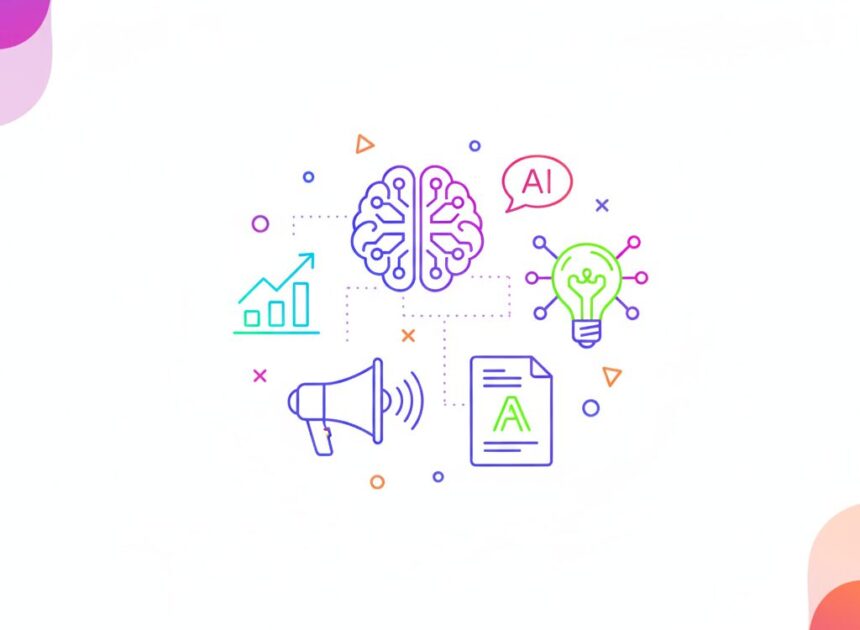From brainstorming your next big campaign to launching the final ad, the marketing workflow as we know it is being fundamentally transformed. What once felt like a futuristic buzzword is now an indispensable part of the modern marketer’s toolkit. Generative AI is no longer just for early adopters; it’s a powerful engine for efficiency, creativity, and measurable growth.
This guide moves beyond the abstract theory. We’ll explore 10 practical, real-world examples of how you can leverage generative AI for marketing right now. These aren’t just neat tricks—they are actionable strategies designed to save you time, deepen customer connections, and drive tangible results for your business.
Generative AI for Content Strategy & SEO
The foundation of modern marketing is a strong content and SEO strategy. But the research and creation process can be a major bottleneck. AI acts as a strategic partner, helping you build a stronger foundation faster than ever before.
Example 1: Accelerate Topic Ideation and Keyword Clustering
The old way of finding topics involved hours spent buried in keyword research tools and messy spreadsheets. Generative AI can streamline this entire process. Instead of just finding individual keywords, you can use it to build out entire thematic clusters that establish your brand’s topical authority.
Ask an AI tool to act as an SEO strategist. Feed it a core topic, and it can instantly generate:
- Main Topic Clusters: The key pillars of your content strategy.
- Long-Tail Keywords: Specific, high-intent queries your audience is searching for within each cluster.
- Engaging Blog Titles: Ready-to-use headlines that capture attention and include relevant keywords.
This approach transforms your content plan from a scattered list of keywords into a cohesive, authority-building web. You save dozens of research hours and get a strategically sound plan in minutes.
Example 2: Scale High-Quality First Drafts with AI Content Creation
“AI-written content is generic.” This is a common concern, but it misses the point. The power of AI content creation isn’t to replace writers, but to empower them. Think of AI as the world’s fastest research assistant and first-draft writer. It can instantly overcome writer’s block and produce a structured draft, freeing up your human talent to focus on what matters most: adding unique insights, expert opinions, brand voice, and strategic edits.
For the best results, provide a detailed prompt that includes:
- The target audience and their pain points.
- Your specific brand tone of voice.
- A clear outline or key points to cover.
- Primary and secondary keywords to include.
By using AI to handle the initial heavy lifting, your content team can produce more high-quality, polished content in a fraction of the time.
Example 3: Automate SEO Metadata for Hundreds of Pages Instantly
Writing unique, compelling, and character-limited title tags and meta descriptions for every single page on a large website is a soul-crushingly tedious task. For e-commerce sites or businesses with hundreds of blog posts, it’s often neglected, leading to poor click-through rates from search results.
This is a perfect task for generative AI for marketing. Using tools like ChatGPT with file uploads or an API, you can provide a list of URLs and page titles and ask the AI to generate optimized metadata in bulk. You can set specific rules, such as character limits, keyword placement, and a call-to-action style, ensuring every page is perfectly optimized for search engine results pages (SERPs).
Generative AI for Personalization and Engagement
Generic, one-size-fits-all marketing is dead. Consumers expect personalized experiences that speak directly to their needs. AI makes it possible to deliver this level of personalization at a scale that was previously unimaginable.
Example 4: Craft Hyper-Personalized Email Nurture Sequences
Instead of blasting your entire list with the same message, use AI to build email sequences tailored to different customer segments. You can feed the AI context about a specific group—for example, “new subscribers who downloaded our guide to social media marketing”—and it will draft a multi-touch email campaign that speaks directly to their interests and stage in the buyer’s journey. Using ChatGPT for marketing in this way can dramatically increase engagement and guide leads toward conversion more effectively.
Example 5: Generate Diverse Social Media Ad Copy and Captions
Ad fatigue is real. To keep campaigns fresh and effective, you need a constant stream of new creative and copy variations for testing. AI is an incredible brainstorming partner for this. Describe your product, your target audience, and the core value proposition, and an AI tool can generate dozens of ad copy variations in seconds.
You can ask for different angles, tones, and calls-to-action, allowing you to quickly A/B test:
- Pain-point-focused copy
- Benefit-driven headlines
- Question-based hooks
- Urgency-driven calls-to-action
This allows you to find the messaging that resonates most with your audience, improving your return on ad spend (ROAS) and speeding up your creative testing cycle.
Example 6: Develop Compelling Video Scripts for Shorts, Reels, and TikTok
The demand for short-form video is insatiable, but coming up with fresh ideas and scripts can be a major creative drain. Use generative AI to structure your videos for maximum impact. It understands the proven formulas that work on these platforms (e.g., Hook – Problem – Agitate – Solution – CTA). You can ask it to write a 30-second video script, complete with suggestions for on-screen text and visuals, turning a vague idea into a shoot-ready script in minutes.
Generative AI for Market Research & Creative Production
Beyond text, AI is revolutionizing how we understand our market and visualize creative ideas. These tools provide a powerful new lens for strategy and production.
Example 7: Brainstorm and Visualize Unique Ad Creative Concepts
Stuck in a creative rut? Use AI image generators like Midjourney or DALL-E to bring your ideas to life. Instead of trying to describe a complex visual concept to a designer, you can generate a high-quality mockup with a simple text prompt. Describe the scene, style, lighting, and mood you want to evoke. This is perfect for brainstorming campaign visuals, social media graphics, or unique blog post headers, drastically shortening the time from initial concept to a tangible creative asset.
Example 8: Conduct Rapid Competitor and Customer Sentiment Analysis
Understanding what customers are saying about you and your competitors used to involve days of manually sifting through reviews, social media comments, and forums. Now, you can export this data into a file and use an AI tool to analyze it. In minutes, it can summarize thousands of data points to identify:
- Key themes and recurring topics.
- The most common customer complaints.
- The most celebrated product features.
- Overall brand sentiment (positive, negative, neutral).
This provides invaluable, data-driven insights that can inform your marketing messaging, product development, and overall competitive strategy.
Example 9: Streamline Podcast and Voiceover Scripting
Whether you’re launching a company podcast or producing a marketing video, a well-written script is essential. AI can help structure podcast episodes, write compelling ad reads, and draft clear and concise voiceover scripts. By providing the topic and desired tone, you can get a polished, conversational script that’s ready for recording, ensuring consistent quality and speeding up your audio and video production workflows.
The Future: Integrating Advanced AI into Your Workflow
The most effective marketers are not just using AI for one-off tasks; they are integrating it deeply into their daily operations.
Example 10: Building a Custom Brand Voice with ChatGPT for Marketing
One of the most powerful and underutilized features of tools like ChatGPT is the ability to define a custom brand voice. You can create a detailed set of instructions that teaches the AI your brand’s specific personality, tone, and formatting rules.
Include details like:
- Words you always use (and words you never use).
- Your target audience’s reading level.
- Your preferred sentence structure (e.g., “use short, declarative sentences”).
- Rules for formatting, like using bullet points or bold text.
By doing this, you create a “brand-trained” AI assistant that generates content that is consistently on-brand, making every output more authentic and useful from the start.
A Look Ahead: Vetting the Best AI Marketing Tools for 2025
The AI landscape is evolving at a breakneck pace. As you look ahead, the conversation will shift from general-purpose tools to specialized platforms. The best AI marketing tools 2025 will be those that integrate seamlessly into the platforms you already use. Look for tools that offer deep integration with your CMS, email marketing platform, and ad managers. Prioritize solutions built for specific marketing functions—like SEO, social media management, or conversion rate optimization—to gain a true competitive edge.
Conclusion
Generative AI for marketing is far more than a content-writing machine. It’s a versatile, strategic partner that can enhance nearly every facet of your job, from initial market research and SEO strategy to hyper-personalized engagement and creative production. It empowers you to work faster, smarter, and more creatively.
The key is to view AI not as a replacement for human marketers, but as a powerful collaborator. Your expertise, strategic thinking, and creativity are still the most important ingredients. AI just helps you apply them at a scale and speed that was never before possible.
Your challenge is this: pick just one example from this list and commit to implementing it in your marketing strategy this quarter. Start small, learn, and then expand.
What are your favorite AI tools for marketing? Share them in the comments below—let’s learn from each other







